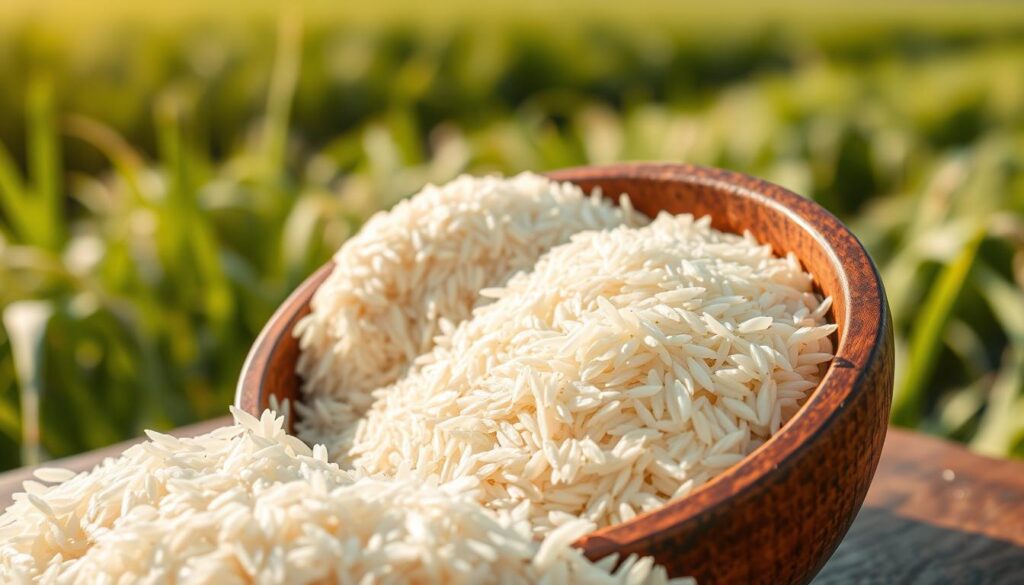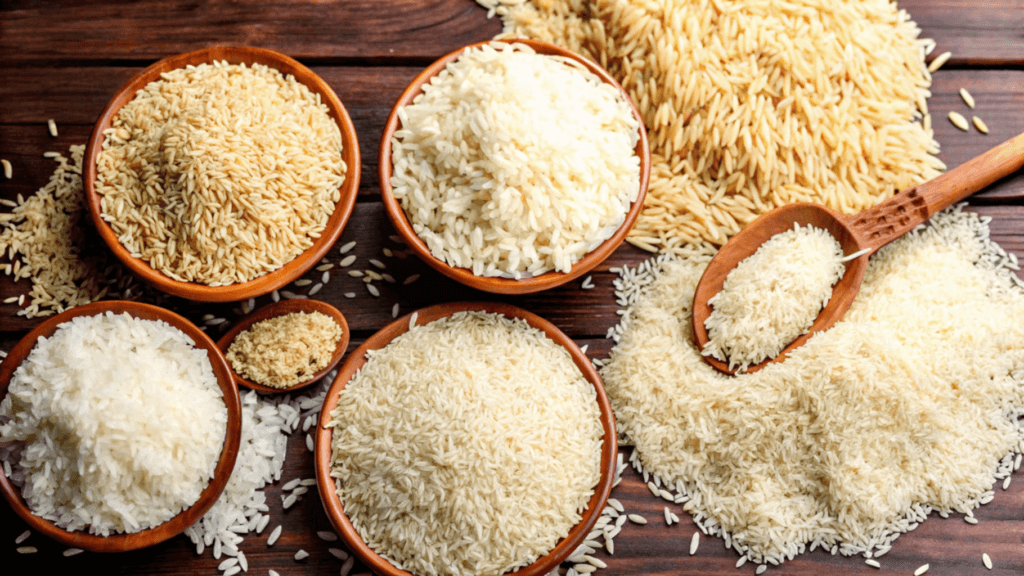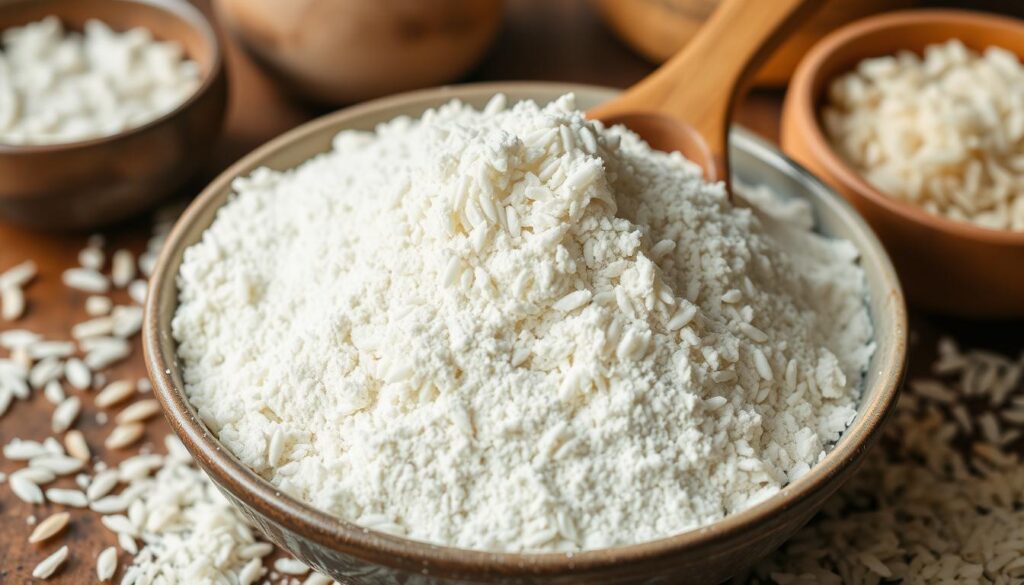Understanding which rice is safe for a gluten-free diet is key. Rice is usually glutenless, but some types or how it’s prepared can be different. We’ll look at the gluten-free status of various rice types and share important facts.
Plain rice like brown, white, basmati, and black rice are usually glutenless. But, they must be kept away from gluten during processing and storage. Flavored rice mixes and some restaurant dishes might have gluten, so be careful.
Glutinous rice, despite its name, is glutenless. It’s used in Asian cooking and doesn’t have the gluten found in wheat, barley, or rye. It’s safe for people with celiac disease or gluten sensitivity.
Choosing rice from trusted brands like Lundberg Family Farms and Alter Eco is smart. These brands focus on gluten-free rice and prevent cross-contamination. Lundberg even offers glutenless flavored rice mixes that are safe.
Even gluten-free rice can get contaminated in restaurants or kitchens. If you’re wondering about rice dishes like pilaf, check out Is Rice Pilaf Gluten Free? Discover the Facts! to learn more about how ingredients and preparation methods can affect its gluten-free status.
Table of contents
- Understanding Gluten in Grains
- The Rice Spectrum: Types of Rice
- Common Misconceptions About Rice
- Cross-Contamination Risks
- Rice Flour: Gluten Concerns
- Reading Labels: What to Look For
- Health Implications of Gluten Consumption
- Conclusion: Making Informed Choices
- FAQ
- What types of rice are gluten-free?
- Is glutinous rice gluten-free?
- Are there any gluten-free rice brands I should look for?
- Can I get gluten in rice dishes at restaurants?
- Is jasmine rice gluten-free?
- Is basmati rice gluten-free?
- Can cross-contamination affect the gluten-free status of rice?
- Is rice flour always gluten-free?
- What should I look for on food labels to ensure rice is gluten-free?
- Can someone with gluten sensitivity still react to rice?
Understanding Gluten in Grains
Gluten is a protein found mainly in wheat, barley, and rye. It makes dough chewy. But, not all grains have gluten. Knowing which rice types have gluten is key for those on a glutenless diet.
What is Gluten?
Gluten is made of gliadin and glutenin proteins. These give dough its elastic and sticky feel. It’s vital for keeping food shapes and structures, especially in baked goods.
Why Some Grains Contain Gluten
Wheat, barley, and rye naturally have gluten. But, rice does not. Rice has orzenin, a protein that’s safe for most people. Yet, gluten can still get into glutenless rice products during processing.
“Gluten must be present in a food at less than 20 parts per million to be considered gluten-free.”
It’s important to know the difference between gluten-containing and gluten-free grains. This helps those on a gluten-free diet avoid health issues.

The Rice Spectrum: Types of Rice
Rice comes in many varieties, each with its own special traits. This is important for those who need to avoid gluten. Knowing about different types of rice helps you choose what’s best for your diet.
White Rice: Is it Safe?
White rice is usually gluten-free and safe for people with gluten issues. It’s made from the starchy part of the grain, with the outer layers removed. This means white rice doesn’t have gluten-like substances that can be a problem.
Brown Rice: A Gluten-Free Option?
Brown rice keeps its outer layers, which are full of nutrients. It’s also gluten-free. But, it might have more arsenic than white rice because of its outer layers. This is something to think about if you’re watching your arsenic intake.
Specialty Rice Varieties
There are many rice types beyond white and brown. Specialty rice like wild, black, and red rice are usually glutenless. But, always check the labels for gluten and watch out for cross-contamination.
Rice comes in over 40,000 types worldwide. From Basmati and Jasmine to Arborio and Sushi rice, each has its own taste and texture. By learning about these different rices, you can explore glutenless options with ease and enjoy a wide range of rice dishes.
Common Misconceptions About Rice
There are a few common misconceptions about rice. Two of the most prevalent myths are about the gluten content of jasmine and basmati rice.
Is Jasmine Rice Gluten-Free?
Yes, jasmine rice is naturally glutenless. It’s a staple in many Asian cuisines and safe for those on a gluten-free diet. The myth that jasmine rice has gluten might come from confusion with flavored or seasoned rice products that include gluten.
Basmati Rice and Gluten: What to Know
Like jasmine rice, basmati rice is also naturally glutenless. It’s a long-grain, aromatic rice often used in pilafs and biryanis. The idea that basmati rice has gluten is not true. It might come from instances where basmati rice is mixed with gluten-containing ingredients.
Remember, plain rice varieties like jasmine and basmati are glutenless. Gluten in rice-based dishes or products usually comes from added ingredients, not the rice itself. Always check labels and ask about preparation methods when dining out to make sure your rice is gluten-free.

Cross-Contamination Risks
Keeping a gluten-free diet safe is a big challenge. Rice, thought to be safe, can still get contaminated. It’s important to know how this happens and how to stop it for those with gluten issues.
How Cross-Contamination Occurs
Rice might touch gluten grains like wheat or barley during farming or processing. Studies show 20.5% of gluten-free packaged foods have gluten above safe levels. This shows cross-contamination is a real risk, even in rice products.
Preventing Cross-Contamination at Home
- Use separate cooking tools for gluten-free and gluten foods.
- Clean all surfaces well before making gluten-free meals.
- Make a gluten-free area in your kitchen to reduce risks.
By following these steps, you can keep your rice and gluten-free foods safe. Being careful about cross-contamination is key to a healthy gluten-free life.

“Around 10% of the population needs a gluten-free diet for health reasons.”
Even a little gluten can harm those with gluten sensitivities. Knowing and avoiding cross-contamination helps you enjoy gluten-free rice options safely.
Rice Flour: Gluten Concerns
Many think rice flour is safe for those with gluten issues. But, it’s not that simple. Rice flour is gluten-free, but it can get contaminated during processing. This is a big worry for people with gluten sensitivities or celiac disease.
Is Rice Flour Always Gluten-Free?
The answer is not always yes. Rice flour can pick up gluten from other grains like wheat, barley, or rye. This happens during milling, packaging, or transport. Facilities that handle many flours can be risky for those with gluten issues.
To make sure your rice flour is glutenless, look for certified products. Check for the gluten-free label or a seal from groups like the Gluten-Free Certification Organization (GFCO) or the Celiac Sprue Association (CSA).
Uses of Rice Flour in Cooking
Rice flour is great for gluten-free cooking and baking. It can replace wheat flour in bread, pasta, and as a thickener in sauces and soups. But, be careful with pre-made rice flour products. They might have gluten too.
When using rice flour, always read labels. Choose products that are certified gluten-free. This keeps your dishes safe for those with glutinous rice gluten or rice varieties containing gluten sensitivities.

“Consuming rice-based products can be a significant source of arsenic exposure, which can lead to various health issues. It’s crucial to be mindful of the potential risks and take appropriate steps to mitigate them.”
Knowing the details about rice flour helps you use it safely in glutenless cooking. This way, you can enjoy its versatility without worrying about gluten.
Reading Labels: What to Look For
When you’re out shopping for gluten-free foods, it’s key to read labels carefully. Gluten can sneak into foods in unexpected ways. Knowing what to look for on labels helps make sure your rice and rice products are glutenless.
Understanding Food Labels
First, check for “gluten-free” labels on the packaging. This means the product has been tested and meets strict standards. Watch out for hidden gluten in ingredients like modified food starch, malt flavoring, and certain dextrins.
Identifying Gluten-Free Certifications
Get to know the gluten-free certifications like the Gluten-Free Certification Organization (GFCO) and the Celiac Sprue Association (CSA). These groups test products to ensure they have less than 20 ppm of gluten. This is the FDA’s limit for gluten-free products in the U.S.
| Gluten-Free Certification | Certification Details |
|---|---|
| Gluten-Free Certification Organization (GFCO) | Requires products to contain less than 10 ppm of gluten |
| Celiac Sprue Association (CSA) | Ensures products meet the FDA’s 20 ppm gluten-free standard |
By learning about food labels and gluten-free certifications, you can easily find glutenless rice options. This way, you can be sure your diet meets your needs.

Health Implications of Gluten Consumption
For people with gluten sensitivity or celiac disease, eating gluten can be very harmful. It’s important to know the symptoms and long-term effects. This helps them make better food choices.
Symptoms of Gluten Sensitivity
Gluten sensitivity can cause many problems. These include bloating, diarrhea, and stomach pain. It can also lead to feeling tired, headaches, and skin issues like rashes or eczema.
In severe cases, like celiac disease, gluten can damage the intestines. This increases the risk of serious health problems later on.
Long-term Effects of Gluten Intake
For those with gluten sensitivity, long-term gluten use can cause big problems. It can lead to nutrient deficiencies and a higher chance of other autoimmune diseases. It can also damage the intestines.
Some people may react to orzenin protein in rice, even though rice is glutenless. This is because of how their body reacts to it.
Even without gluten sensitivity, eating gluten can still harm. It can raise the risk of type 2 diabetes, heavy metal poisoning, and changes in the gut. Eating a balanced diet and watching out for gluten in foods, including some rice, can help avoid these risks.
“Consuming processed gluten-free foods as a primary diet staple could contribute to a higher risk of obesity due to the potential presence of refined sugars and saturated fats in these products.”
Knowing the symptoms and long-term effects of gluten helps people make better food choices. This way, they can take care of their health and well-being.
Conclusion: Making Informed Choices
Most plain rice types, like white, brown, and wild, are glutenless. But, flavored rice or dishes might have gluten. Always check labels and tell servers about your diet when eating out.
Summary of Gluten-Free Rice Options
Choose certified gluten-free rice to avoid cross-contamination. Plain rice is safe and easy to use. Try different types like basmati, jasmine, and wild rice to find what you like.
Tips for Safe Rice Consumption
Be careful about cross-contamination when cooking rice. Clean surfaces and utensils well. Tell restaurant staff about your gluten-free diet and ask how rice is prepared. This way, you can enjoy rice safely and healthily.
This article is related to
FAQ
What types of rice are gluten-free?
Most types of rice are gluten-free. This includes whole-grain brown rice, white rice, basmati rice, and black rice. But, flavored rice mixes might have gluten.
Is glutinous rice gluten-free?
Yes, glutinous rice is gluten-free. It doesn’t have the gluten protein found in wheat, barley, and rye.
Are there any gluten-free rice brands I should look for?
Yes, Lundberg Family Farms and Alter Eco offer gluten-free rice products. They are good options to consider.
Can I get gluten in rice dishes at restaurants?
Be careful with rice dishes at restaurants, especially sushi rice. It might have gluten from vinegar or soy sauce.
Is jasmine rice gluten-free?
Yes, jasmine rice is naturally gluten-free. The confusion about gluten in jasmine rice comes from flavored rice products or dishes with gluten.
Is basmati rice gluten-free?
Yes, basmati rice is naturally gluten-free. Make sure to distinguish between plain rice and rice dishes or products with gluten.
Can cross-contamination affect the gluten-free status of rice?
Yes, cross-contamination can happen during farming, processing, or cooking. Rice might touch gluten-containing grains. Using the same utensils or cooking surfaces can also cause cross-contamination.
Is rice flour always gluten-free?
Rice flour is naturally gluten-free. But, processing can lead to cross-contamination. Always choose certified gluten-free rice flour for safety.
What should I look for on food labels to ensure rice is gluten-free?
Look for “gluten-free” claims on labels. Be aware of hidden gluten in ingredients like modified food starch, malt flavoring, and certain dextrin. Know about gluten-free certifications from organizations like the Gluten-Free Certification Organization (GFCO).
Can someone with gluten sensitivity still react to rice?
Some people might react to the orzenin in rice, even if it’s gluten-free. Gluten intake can lead to nutrient deficiencies, increased risk of autoimmune disorders, and intestinal damage for sensitive individuals.





